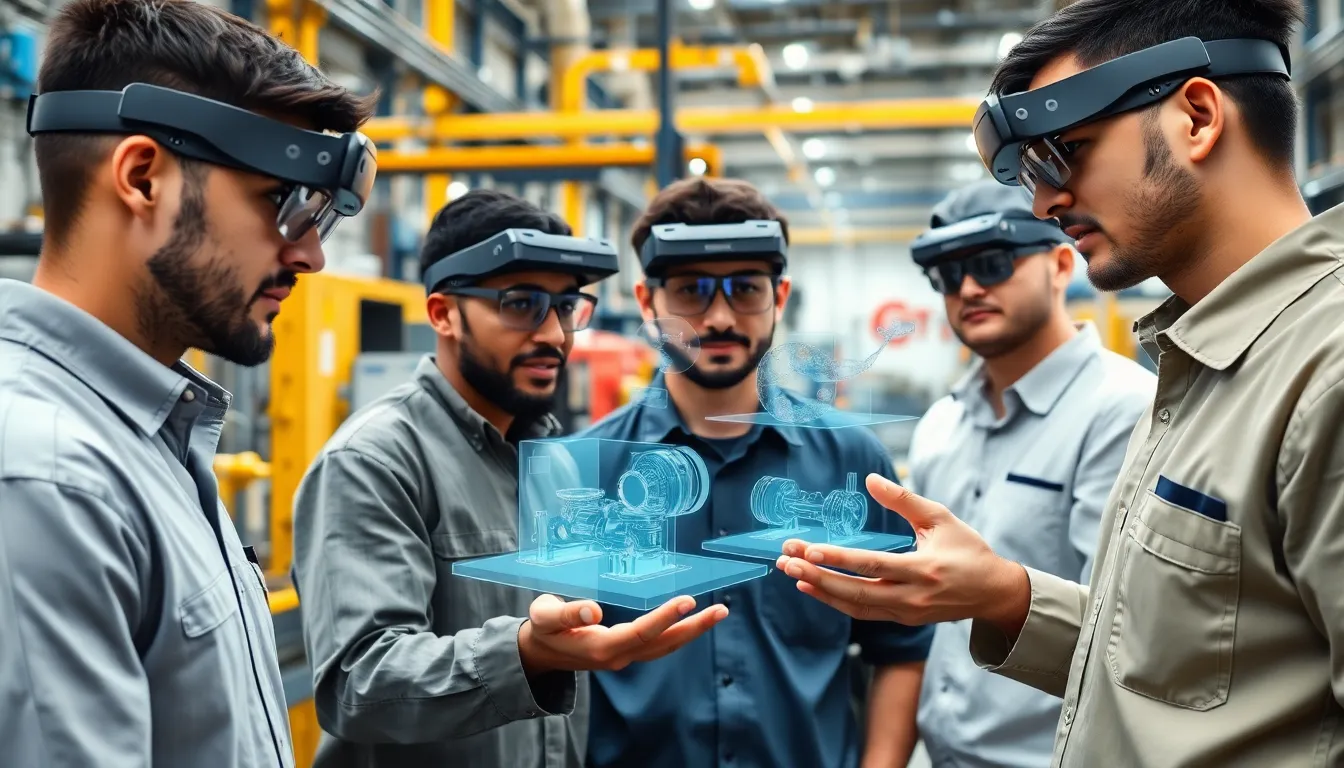Imagine walking into a factory where machines greet you with a friendly wave and your tools whisper sweet nothings about their maintenance needs. That’s the magic of augmented reality (AR) in industry. It’s not just a techy buzzword; it’s a game-changer transforming how businesses operate, making processes smoother and more efficient.
Table of Contents
ToggleOverview Of Augmented Reality In Industry
Augmented reality enhances industrial operations by overlaying digital information onto the physical environment. It integrates real-time data into workflows, improving decision-making and productivity. For example, assembly line workers use AR glasses to visualize complex instructions, reducing error rates and speeding up training.
Manufacturing sectors benefit significantly from AR applications. Maintenance technicians utilize AR for equipment diagnostics, receiving instant access to repair manuals and 3D schematics. This access leads to quicker repairs and less downtime, which directly impacts operational efficiency.
Logistics companies employ AR for inventory management. Employees can scan items to receive immediate information regarding stock levels and locations, streamlining the supply chain process. This technology mitigates the risk of human error and enhances accuracy in order fulfillment.
In construction, AR aids project visualization, allowing teams to review 3D models overlayed on job sites. Crew members visualize architectural designs against existing structures, facilitating better coordination and reducing costly mistakes.
Training and safety protocols also see improvements through AR. Interactive simulations help employees practice procedures in a safe environment, reinforcing knowledge retention without the risks associated with real-world training. Integration of AR into onboarding processes leads to faster acclimatization for new hires.
Overall, augmented reality addresses various challenges within industry, driving transformation through enhanced efficiency, reduced costs, and improved safety measures. Embracing this technology enables businesses to remain competitive in a rapidly evolving market.
Applications Of Augmented Reality

Augmented Reality (AR) finds diverse applications across various industrial sectors. Its integration transforms processes and boosts overall efficiency.
Manufacturing
Manufacturing benefits significantly from AR technologies. Workers access complex assembly instructions via AR glasses, reducing error rates. Visualization of components in real-time streamlines assembly and helps in meeting production deadlines. Digital overlays also assist in inspecting parts, ensuring quality control. Additionally, AR fosters collaboration among teams, allowing real-time input from remote experts.
Maintenance And Repair
Maintenance and repair tasks improve with the help of AR applications. Technicians use AR devices to access step-by-step repair guides while hands-free, leading to faster resolutions. Instant access to 3D schematics allows for precise understanding of machinery, reducing downtime. Equipment servicing becomes more efficient, as AR helps identify issues before they escalate into significant problems.
Training And Education
Training and education revolutionize with AR integration. Employees engage in interactive simulations that provide hands-on experience without risks. Such environments allow for the practice of procedures, enhancing knowledge retention. New hires undergo accelerated onboarding as AR showcases workflows and equipment functionality in an immersive manner. Consequently, this approach boosts confidence and competency among staff members.
Benefits Of Augmented Reality In Industry
Augmented reality (AR) significantly enhances industrial operations across various sectors. Companies leverage AR technologies to optimize processes and improve outcomes.
Improved Efficiency
AR improves efficiency by streamlining workflows. Workers access real-time data, enhancing decision-making. For assembly line tasks, AR displays complex instructions, leading to fewer errors. Visibility of components in 3D aids teams in collaboration, reducing the time needed to complete projects. Technicians utilize AR for maintenance, pulling up necessary repair guides instantly. This immediate access accelerates repairs, resulting in minimal downtime.
Enhanced Safety
Safety protocols benefit greatly from AR integration. Simulations allow employees to practice procedures in a controlled environment. Such interactive training reinforces knowledge retention and confidence. By using AR, workers experience real-life scenarios without the associated risks. This immersion ensures that safety measures become second nature. Consequently, industries report fewer workplace accidents and incidents.
Cost Reduction
Cost reduction emerges as a significant advantage of AR utilization. Streamlining processes leads to lower operational expenses. With fewer errors during manufacturing, rework diminishes, resulting in savings. Technicians completing repairs faster contribute to reduced labor costs. Moreover, enhanced training minimizes onboarding time for new employees, saving time and resources. Businesses leveraging AR can thus optimize budgets while maintaining high-quality standards.
Challenges Of Implementing Augmented Reality
Augmented reality faces several challenges that can hinder its implementation in industry settings.
Technical Limitations
Technical limitations create hurdles for adopting augmented reality. High development costs often restrict access to AR technology, especially for small businesses. Another concern involves hardware restrictions; devices may lack the processing power required for optimal AR experiences. Network connectivity also impacts functionality; unreliable internet can disrupt real-time data transmission essential for AR applications. Additionally, creating high-quality, interactive content requires specialized skills that may not be readily available within the workforce.
Workforce Training
Workforce training presents another challenge in implementing augmented reality. Employees must adapt to new systems, which can require significant time and effort. Resistance to change often emerges, particularly among those accustomed to traditional methods. Training programs need to be comprehensive yet engaging, ensuring users understand AR tools quickly. Regular refresher courses may be necessary to maintain proficiency, illustrating the ongoing commitment required to fully integrate AR into everyday tasks.
Integration With Existing Systems
Integration with existing systems poses a significant obstacle in leveraging augmented reality effectively. Many industries rely on established technologies that may not support AR platforms easily. Compatibility issues often arise, creating gaps in workflows. Data silos can hinder seamless information sharing between AR tools and existing software. Careful planning and evaluation become crucial to ensure that all systems work harmoniously. Collaboration with IT departments can facilitate smoother transitions and enhance overall effectiveness.
Augmented reality is reshaping the industrial landscape by enhancing efficiency and safety while driving significant cost reductions. As businesses increasingly adopt AR technologies, they unlock new levels of productivity and innovation. The potential for streamlined workflows and improved training methods positions AR as a crucial tool for companies aiming to stay competitive.
While challenges like technical limitations and workforce adaptation exist, they can be overcome with strategic planning and robust training initiatives. Embracing AR not only addresses immediate operational hurdles but also prepares industries for future advancements. The journey towards full AR integration may be complex, but the rewards are undeniable, positioning industries for sustainable growth in an ever-evolving market.



